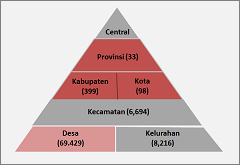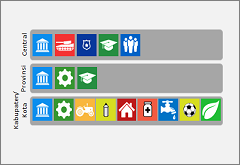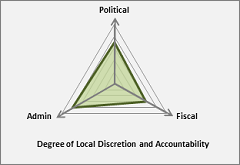Country Profile Background
Indonesia’s public sector is defined by the ‘Big Bang’ decentralization reform which were adopted in 1999 and introduced on January 1, 2001. These reforms fundamentally changed the source of accountability and responsibility for service delivery across the country. Whereas previous to this point all public services were delivered in a centralized or deconcentrated manner, in 2001, almost all functions were devolved to the district level (kabupaten/kota). Despite significant progress towards becoming more democratic and decentralized, vestiges of the previous (highly centralized and authoritarian) regime remain. While subnational governments now have the authority and responsibility for many public services, they still face constraints in capacity, autonomy and accountability in fulfilling their duties under the law.
Organizational/Governance Structure of the Public Sector
Indonesia’s public sector consists of three main government levels: central, provincial and district. The country is divided into 33 provinces, which in turn are composed of regencies or districts (kabupaten) and cities (kota). At each of these levels, the political leadership is elected by popular vote every 5 years. Three provinces -Aceh, Papua, and West Papua- have a special status granting them a higher degree of autonomy, whereas Jakarta and Yogyakarta are also recognized as Special Regions.
Kabupaten and kota are further broken down into 6,694 sub-districts (kecamatan), which are administrative sub-units of the district level. Below the sub-district level, there are 69,249 villages (desa) and 8,216 urban villages (kelurahan). Desa leaders are elected and have authority over local people in accordance to local traditions whereas kelurahan have less power and are comprised of civil servants directly responsible to the head of their kecamatan.
Functional Responsibilities of the Local Public Sector
As part of Indonesia’s ‘big bang’ approach to decentralization, the Regional Autonomy Law (Law 22/1999) assigned responsibility for 26 functions to the local government level. While the national government retains exclusive jurisdiction over national functions (such as national defense, public order, social protection and policy standards), the responsibility for most social and economic services (including basic education and health services) was transferred to the kabupaten/kota level. Provinces mainly function as an intermediate government level, but are also responsible for certain services that are provincial in scale or concern.
Fiscal Profile of the Public Sector
About half (48.3%) of public sector expenditures in Indonesia take place within the local public sector. Just under one-third (29.1%) of total public expenditures take place at the local (kabupaten/kota) level while another 9.5% of public expenditures are made at the provincial level. This reflects the functional responsibilities assigned to local government. In addition to these provincial and local expenditures, 9.7% of total public expenditures are made by central government ministries for public services that are delivered at the local level. The national government retains 51.7% of public sector resources for national functions and activities that fall outside the local public sector.
The majority (77.8%) of local public sector revenues come in the form of transfers, with 71.1% of revenues in the form of general purpose transfers (revenue sharing and equalization grants, known as the DAU) and 6.7% in the form of earmarked transfers (including capital grants, known as the DAK). Revenues from property taxes, income taxes and natural resource revenues are shared between the central and local level on a derivation basis. Own source revenues account for 22.3% of local public sector revenues.
Institutional Profile of the Local Public Sector
Kabupatan/kota governments (see graph) are semi-autonomous subnational government bodies with their own elected political leadership, elected every 5 years. While national electoral legislation prevents the emergence of separatist regional political parties, provincial and local government elections are quite competitive. Local governments have a considerable degree of discretion over their own administration, such as the ability to recruit, hire, and dismiss staff, and the authority to procure their own capital infrastructure. In addition, provincial and kabupatan/kota governments prepare, adopt and implement their own budgets and control and manage their own bank accounts. While local governments can collect their own revenues, they remain heavily dependent on transfers from the national government.
Country Profile Information
Complete LPS Country Profile: Indonesia (PDF)
Complete LPS Country Profile: Indonesia (XLS)





